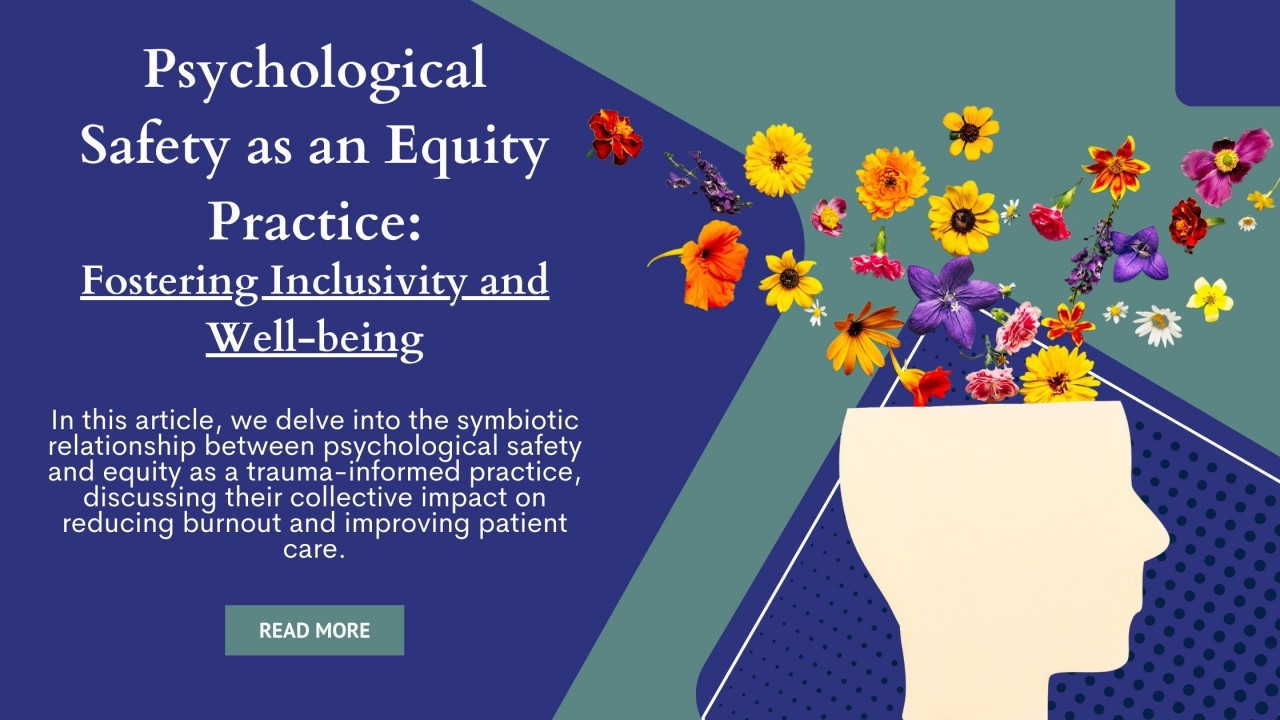(404) 793-0011 | drmaiysha@drmaiysha.com
Psychological Safety as an Equity Practice: Fostering Inclusivity and Well-being
In the rapidly evolving landscape of modern workplaces, the concepts of psychological safety and equity have emerged as cornerstones for creating a thriving environment. Psychological safety, often associated with open communication and risk-taking without fear of negative consequences, has gained significant attention. However, its connection to equity practices, trauma-informed care, and its potential to alleviate burnout while enhancing patient care often remain overlooked. In this article, we delve into the symbiotic relationship between psychological safety and equity as a trauma-informed practice, discussing their collective impact on reducing burnout and improving patient care.
Understanding Psychological Safety and Equity as Partners
Psychological safety can be best described as the shared belief within a team that one can express their thoughts, ideas, and concerns without fear of reprisal or humiliation. It sets the foundation for open dialogue, collaboration, and innovation within workplaces. When combined with equity practices—ensuring fairness, impartiality, and representation for all employees— psychological safety becomes a powerful catalyst for inclusivity and well-being.
An equity-driven approach acknowledges that individuals have unique experiences, backgrounds, and needs. This recognition aligns perfectly with the principles of trauma-informed care, which aims to create an environment that acknowledges and addresses the potential trauma individuals might have experienced. By integrating psychological safety into equity practices, organizations can establish an environment where employees feel respected, heard, and valued.
Trauma-Informed Care and Psychological Safety
Trauma-informed care revolves around the idea that individuals' behaviors and reactions can be understood through the lens of their past experiences, especially those involving trauma. Creating a workplace that is sensitive to this perspective requires fostering an atmosphere of psychological safety. When employees feel secure in sharing their concerns and experiences, they are more likely to reveal any past traumas that may impact their work interactions or performance.
By integrating trauma-informed principles into an equity-focused approach, organizations recognize the potential triggers that might arise due to historical or personal trauma. This understanding enables leaders to tailor their communication, policies, and practices to mitigate unintentional harm, thus fostering an environment that supports healing and growth.
Reducing Burnout and Enhancing Patient Care
One of the most compelling outcomes of incorporating psychological safety and equity practices is their collective potential to reduce burnout among employees. Burnout, often driven by chronic stress, lack of control, and a feeling of being undervalued, can have detrimental effects on both individual well-being and patient care. However, when psychological safety is established as an essential element of the workplace culture, employees are more likely to voice their concerns and seek support before burnout reaches critical levels.
Furthermore, fostering psychological safety and equity practices can lead to improved patient care. When healthcare professionals are confident that their voices are heard and their well-being is prioritized, they can focus more on delivering empathetic and patient-centered care. Inclusion and diverse perspectives also lead to more innovative solutions and enhanced communication among medical teams, ultimately benefiting the patients.
Creating a Culture of Psychological Safety Is a Top-Down Process That Starts With the Organization's Leadership
Creating psychological safety as an equity practice and integrating trauma-informed care principles not only fosters a nurturing work environment but also contributes to a more inclusive, innovative, and empathetic workplace. By acknowledging the unique experiences and potential trauma individuals carry, organizations can tailor their approaches to ensure everyone's well-being. As a result, burnout rates decrease, and patient care improves, creating a positive cycle of growth and transformation. It's time for workplaces to recognize that psychological safety and equity are not just concepts, but powerful tools for shaping a brighter future for employees and the communities they serve.
Bring the tools of trauma informed listening and speaking into your organization and create psychological safety for your leaders and staff. Increase productivity, employee satisfaction and retention. Contact us today to learn more about our workplace culture consulting and training. https://mindremappingacademy.com/corporate-programs
Stay Informed
When you subscribe to the blog, we will send you an e-mail when there are new updates on the site so you wouldn't miss them.





Comments